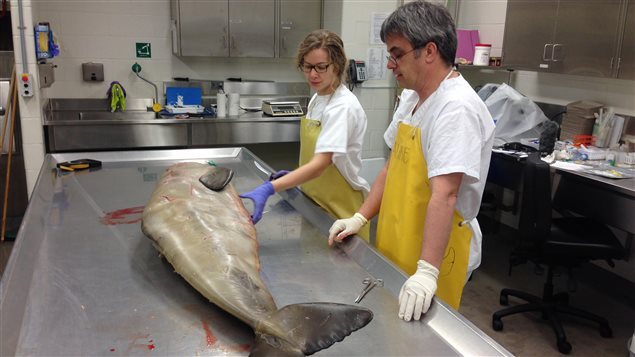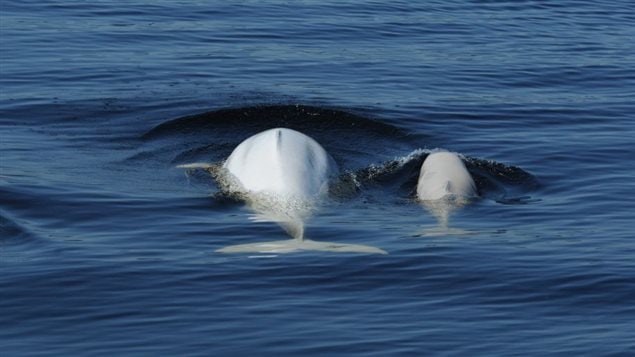For several years marine researchers have been concerned about high mortality of beluga whales in the St Lawrence.
That concern has risen again after analysis of the dead whales found last year.
Of the 14 carcasses found last year, three were pregnant females, and six were of newborn calves. One was identified as hermaphrodite.
In 2014, there were 11 carcasses found, six of which were young or newborn, and in 2013, there were 17 dead beluga, four of which were babies.
Necropsies performed on the dead whales showed the adult females were either pregnant or had just given birth. The babies found showed no signs of disease or trauma leading to the conclusion they had died of starvation or dehydration after being separated from their mothers.
Since 1983 all dead whales have had necropsies performed at the University of Montreal’s faculty of veterinary medicine in St-Hyacinthe.

Robert Michaud, who heads the Group for Research and Education on Marine Mammals (GREMM) at the school says the deaths are very worrisome. He says the beluga population is declining at the rate of one to 1.5 percent every year, even though the mammals have no predators.
He thinks there are a number of factors contributing to the decline. One is the ongoing presence of contaminants in the water. One such chemical is PBDE, a flame retardant once widely used in fabrics, for clothing, drapes, carpets, furniture etc. In beluga it affects the thyroid gland, important to help in expulsion of the foetus during birth..
Other hormone mimicking chemicals are belieived to have contributed to the hermaphrodite beluga found dead in 2015. Hermaphrodism is normally very rare, says one researcher. Only six cases of marine mammals have been found, three of them were beluga from the Saint Lawrence.
Another problem is the reduction of herring prey fish in the region, especially in spring. This may make the females weaker when they need strength for birthing.
Global warming means less ice in the river. The beluga take refuge under the ice, and without it they are more exposed to wind, and buffeting from waves and storms.

Another aspect is noise. All whales communicate through sound and with increased shipping, and a longer season, the noise has both a psychological and physiological affect on the whales, especially during calving. Researcher Stephane Lair of the University says that farmers know to keep things quiet when cattle are birthing, in order to avoid stressing the animals.
Fisheries and Oceans Canada estimates there are now fewer than 900 beluga in the estuary. Fifteen years ago there were about 1000. A century ago there were about 10,000. Beluga hunting was banned in the 1970’s to try to boost the population, but instead it continues to decline.
Both Michaud and Lair evoke the possibility that the beluga are an indicator of the health of St Lawrence, and that they could disappear. They say it wouldn’t necessarily affect the ecosystem, but would represent a huge human failure to recognize and deal with the issues.
RCI-Aug 2013
Scientists concerned over high mortality of St Lawrence belugas
Radio-Canada: Thomas Gerbet (in French)
Fisheries and Oceans Canada: beluga
http://www.dfo-mpo.gc.ca/science/publications/uww-msm/articles/beluga-eng.htm
Fisheries and Oceans Canada: recovery strategy 2012 (pdf)
http://www.sararegistry.gc.ca/virtual_sara/files/plans/rs_st_laur_beluga_0312_e.pdf
David Suzuki Foundation: beluga
http://action2.davidsuzuki.org/belugas
Times Colonist: Call of the baby beluga: documentary
Call of the Baby Beluga Documentary Film (may be geo-blocked outside of Canada)
http://www.cbc.ca/natureofthings/episodes/call-of-the-baby-beluga







For reasons beyond our control, and for an undetermined period of time, our comment section is now closed. However, our social networks remain open to your contributions.